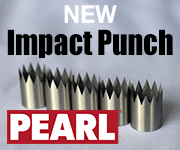Featured Stories
-
Elevating Pouch Manufacturing with Pearl Technologies' Cutting-Edge Solutions
For manufacturers seeking efficiency, precision, and safety in pouch production, Pearl delivers unmatched innovation across three standout... -
Faster Product Composition Analysis Equals Better Quality Assurance
Near Instant Testing and Reduced Costs to be Found -
Methods to Precisely Measure Tension and Web Control
How to Control Automatically Within Set Parameters
News | New Products
-
Nobelus Launches Entry-Level Komfi® Thermal Laminator
FINISHING SOLUTIONS SUPPLIER OFFERS NEW JUNIOR 52 LAMINATING SYSTEM
-
Double E Group Mourns the Loss of Founder and Converting Industry Pioneer, Richard Edward Flagg
Double E Group announces with profound sadness the passing of its founder, Richard Edward “Ed” Flagg, on June 23, 2025. He was 85.
-
Convertech Brand to Fully Transition to Double E Group Same Team, Same Excellence, Unified Name
Double E Group has announced that Convertech, one of its subsidiaries and a trusted provider of core chucks and shaft solutions for the converting industry, will now operate solely under the Double E Group brand.
-
Pulse is Making Print Simple at Labelexpo Europe 2025
Narrow web ink specialist Pulse is Making Print Simple at Labelexpo Europe 2025, as it challenges flexo printers to rethink how they work and shows solutions that turn production bottlenecks into revenue generators.
-
ROTOCON to debut at Labelexpo Europe with three machine demonstrations
ROTOCON will make its Labelexpo Europe debut, exhibiting together with HS Machinery on stand 4D21.
-
At Interphex Japan, IL Group to Showcase Innovative Labeling Solutions and Contract Packaging Services
IL Group, a specialist in multifunctional labeling solutions for the pharmaceuticals and healthcare sectors
-
Revolutionizing Adherence: Clinical Trials Go Digital with Enhanced Key-Pak®
Keystone Folding Box Co., a leading provider of paperboard packaging solutions, has announced a strategic partnership with Med-Con Technologies
Expert Advice
The Effects o Comonomer Type on the Blown Film Performance of LLDPE Resins Made Using a Metallocene Single-Site Catalyst
- Published: February 01, 2001, By Ashish M. Sukhadia et. al.
by Ashish M. Sukhadia, M. Bruce Welch, & Rajendra K. Krishnaswamy, Phillips Petroleum Company; and Syriac J. Palackal, SABIC. Email the author(s) at amsukha@ppco.com
Following is an expanded summary of a complete paper available on the TAPPI web site at tappi.org. On the page, click "the PLACE" in the section designated "Journals."
Application: Using 1-butene, 1-hexene, and 1-octene as a comonomer gives blown film performance that increases with increasing length of the a-olefin used.
Linear low density polyethylene (LLDPE) resins are a very large, important segment of the polyethylene blown cast and film markets worldwide. Synthesizing these resins involves copolymerization with an a-olefin comonomer such as 1-butene, 1-hexene, or 1-octene. This gives an ethylene/a-olefin copolymer with many short chain brances on the polymer backbone. Incorporation of 1-butene, 1-hexene, or 1-octene comonomers gives ethyl (2 carbon), butyl (4 carbon), or hexyl (6 carbon) branches, respectively, on the polymer backbone.
Although the molecular structural differences among the LLDPE materials made with these copolymers may seem trivial or insignificant various researchers have shown that these seemingly minor differences in comonomer type have profound effects on blown film properties. Generally, the researchers have observed that film performance properties such as impact (toughness) and tear strength increase with an increase in the comonomer length, i.e., 1-butene, 1-hexene, 1-octene.
A difficulty in interpreting the results of some earlier studies relates to the fact that the comonomer or short chain branch (SCB) and the comonomer composition distribution (CCD) or short chain branch distribution (SCBD) across the molecular weight distribution (MWD) influence blown film performance. Comonomer type and CCD are therefore important in determining film properties.
Objective This study examined the effects of comonomer type on the blown film properties of metallocene catalyst based LLDPE (mLLDPE) resins. It used a metallocene or single-site catalyst so the three different copolymers prepared would be nearly identical in gross molecular and branching distribution characteristics. This would allow evaluation of the specific effects of comonomer type on blown film properties.
Results
The polyethylene copolymer series examined in this study used a zirconium metallocene catalyst system. The copolymerization of ethylene and respective comonomer used a pilot plant under steady state slurry-loop polymerization conditions. The catalyst, ethylene, comonomer, and other process reactants were fed continuously to the slurry-loop reactor with continuous removal of polymer fluff from the reactor. The individual comonomer/ethylene reactor molar ratios were identical for all resins within experimental error. The fluff underwent purging with nitrogen to remove solvent and unreacted olefins followed by blending with antioxidants and a processing aid and extrusion into pellets. Comparison of the pellets used rheology characteristics and data from nuclear magnetic resonance and gel permeation chromatography.
The three copolymers were converted into blown films of five different gages. Basic blown film properties were measured using dart impact strength, Spencer impact strength, and machine direction and transverse direction Elmendorf tear strengths.
Despite the similarities in the three copolymers, Fig. 1 and other data show significant differences in the blown film physical properties observed. Specifically, the 1-butene copolymer is significantly lower in all the measured physical properties at all five gages evaluated compared with the 1-hexene and 1-octene copolymers. The data in Fig. 1 for Spencer impact shows that the 1-octene copolymer has generally higher toughness than the 1-hexene material at all gages.
Conclusions
The three different metallocene LLDPE copolymer resins made in this study used the same metallocene catalyst and associated synthesis conditions. They were essentially identical resins in terms of rheological, molecular, thermal, and branching distribution (both intramolecular and intermolecular) characteristics. When the copolymers were blown into films at various gauges under identical processing conditions, very significant differences in blown film performance occurred. The 1-butene resin had the lowest film property performance followed by the 1-hexene and 1-octene resins. While reasons for these film property differences remain unknown now, future characterization of the polymer and film samples may help uncover the reasons for the observed film property differences.






















